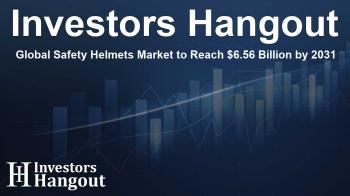Global Safety Helmets Market to Reach $6.56 Billion by 2031

Exploring the Growth of the Safety Helmets Market
The global safety helmets market is set to experience significant growth, aiming to reach a valuation of $6.56 billion by 2031. This forecast is based on extensive research from various industry experts and analysis of market trends. Safety helmets are crucial safety equipment across multiple industries, particularly in construction, manufacturing, and mining.
Key Market Insights and Trends
According to industry research, the safety helmets market was valued at approximately $4.38 billion in 2023, with an anticipated compound annual growth rate (CAGR) of 5.2% through the forecast period. This growth aligns closely with the ongoing expansion of the construction sector, which is seeing a plethora of infrastructural projects worldwide.
Construction Industry Influence
The construction industry plays a pivotal role in the safety helmets market, as it constitutes the largest segment of end-users. As urbanization accelerates globally, the demand for buildings, industrial facilities, and infrastructure projects rises significantly. Regions like the Middle East are at the forefront of this construction boom, backed by substantial investments in mega-projects.
Regulatory Standards Fueling Demand
Another factor contributing to the market's growth is the increased emphasis on workplace safety regulations. Governments are mandating stringent safety measures to protect workers on-site, particularly in high-risk environments like construction and mining. Consequently, this trend escalates the need for advanced safety helmets equipped with innovative technology.
Regional Market Analysis
In 2023, the Asia-Pacific region emerged as a leader in the safety helmets market, closely followed by Europe and North America. The continuous development in construction and infrastructure projects fuels this growth, particularly in rapidly developing economies such as China and India. For instance, a surge in urban development and population growth results in an escalating demand for safety gear.
Europe’s Steady Growth
Europe also shows strong dynamics with countries like the UK, Germany, and Italy reinforcing the safety helmet market. Despite facing economic hurdles, including inflation and geopolitical tensions, the construction and manufacturing sectors continue to thrive, ensuring consistent demand for safety helmets.
Market Segmentation and Applications
The safety helmets market can be subdivided based on material, with polyethylene, acrylonitrile butadiene styrene, and polycarbonate being the primary types used in manufacturing safety helmets. Each material comes with unique benefits, catering to the diverse needs of various industries.
End-User Segmentation
Additionally, the market segments into different end-use industries such as construction, manufacturing, and mining, each accounting for significant portions of overall market consumption. As industrial activities increase, the applications of safety helmets expand, highlighting the gear's vital role in safeguarding workers.
Competitive Landscape and Innovations
The competitive landscape of the safety helmets market features numerous key players, including well-known companies like 3M, Honeywell International, and Pyramex. These firms are continually innovating and launching new products to maintain their market position. For instance, MSA Safety, Inc. recently introduced the MSA Cairns® 1836 Fire Helmet, setting new standards for safety equipment.
Recent Developments
Emerging companies also contribute to the competitive climate with innovative safety products. For example, BIBEE is launching its new helmet, the LAVA-01, aiming to set trends in professional safety gear. These advancements ensure the market remains dynamic and responsive to new challenges.
Conclusion: A Bright Future for Safety Helmets
The interplay of rising urbanization, increased industrial activities, and stringent safety regulations positions the safety helmets market for robust growth. Stakeholders, including manufacturers and component providers, stand to gain valuable insights into navigating this evolving landscape, ensuring the integration of high safety standards.
Frequently Asked Questions
What is driving the growth of the safety helmets market?
The growth is primarily driven by increasing construction activities and stringent safety regulations implemented by governments worldwide.
Which region is leading the safety helmets market?
The Asia-Pacific region currently leads the market, followed by Europe and North America, due to rapid urbanization and ongoing construction projects.
What materials are primarily used in safety helmets?
Common materials include polyethylene, acrylonitrile butadiene styrene (ABS), and polycarbonate, each offering distinct safety benefits.
Which industries contribute most to safety helmet usage?
The construction, manufacturing, and mining industries are the largest consumers of safety helmets due to their high-risk environments.
What are some recent innovations in safety helmets?
Innovations include lightweight materials, improved ergonomic designs, and advanced safety features to enhance protection and comfort for users.
About Investors Hangout
Investors Hangout is a leading online stock forum for financial discussion and learning, offering a wide range of free tools and resources. It draws in traders of all levels, who exchange market knowledge, investigate trading tactics, and keep an eye on industry developments in real time. Featuring financial articles, stock message boards, quotes, charts, company profiles, and live news updates. Through cooperative learning and a wealth of informational resources, it helps users from novices creating their first portfolios to experts honing their techniques. Join Investors Hangout today: https://investorshangout.com/
Disclaimer: The content of this article is solely for general informational purposes only; it does not represent legal, financial, or investment advice. Investors Hangout does not offer financial advice; the author is not a licensed financial advisor. Consult a qualified advisor before making any financial or investment decisions based on this article. The author's interpretation of publicly available data presented here; as a result, they should not be taken as advice to purchase, sell, or hold any securities mentioned or any other investments. If any of the material offered here is inaccurate, please contact us for corrections.
